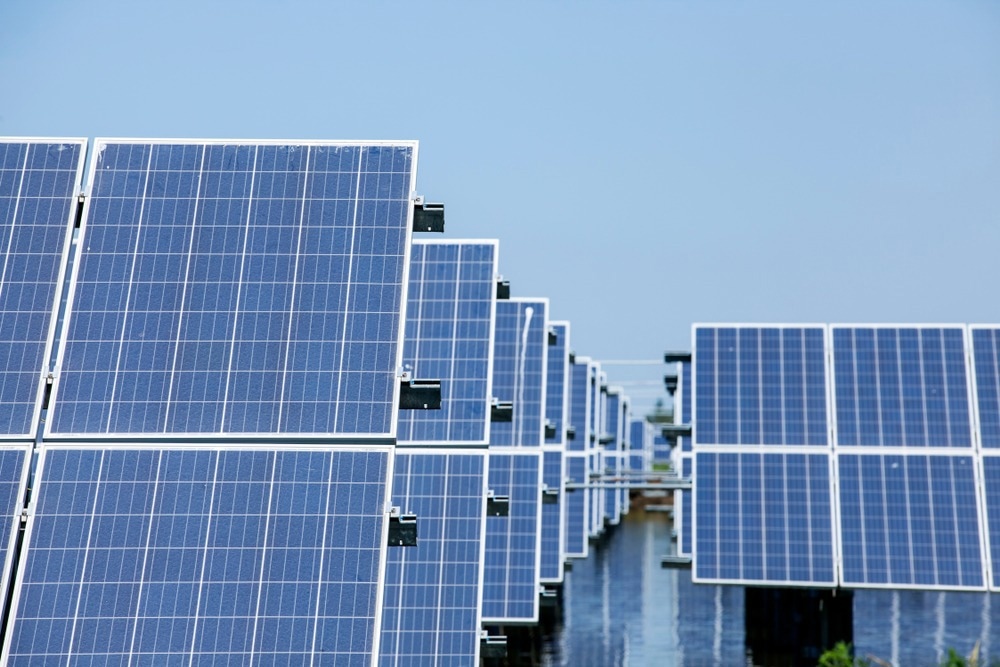The soaring demand for renewable energy requires affordable and efficient technologies that can harness clean energy sources and renewable materials, thus minimizing greenhouse gas emissions and reliance on fossil fuels.

Image Credit: nevodka/Shutterstock.com
Thin film technology can play a crucial role in revamping the renewable energy market by enabling the fabrication of highly efficient flexible solar panels, as well as advanced supercapacitors and batteries for cost-efficient energy storage.
Thin Film Fabrication and Properties
A material layer with a thickness ranging from sub-nanometer (atomic or molecular monolayer) to several micrometers is usually referred to as a thin film. The fabrication of thin films usually involves a vacuum-based deposition process, such as chemical vapor deposition, physical vapor deposition, vacuum sublimation, or a combination of these methods.
In the last two decades, various techniques for thin film self-assembly, such as Langmuir-Blodgett transfer, under ambient (or nearly ambient) conditions were developed.
Depending on the materials and the fabrication methods used, the resulting thin films can be either monocrystalline, polycrystalline, or amorphous. The properties of the thin films can differ substantially from those of the corresponding bulk materials and heavily depend on the films' thickness, composition, and surface morphology.
Over the years, the range of thin film applications rapidly expanded, including microelectronics, data storage, communication, construction, biomedical device fabrication, catalysis, and many others. The versatility of the thin film technology led to its creasing implementation in new and innovative industrial processes for the development of novel, more efficient devices while minimizing production cost and waste compared to conventional manufacturing techniques.
Thin Film Technology for Renewable Energy Applications
Recently, considerable progress has been made in shifting photovoltaic technology from the traditional inflexible silicon-based assemblies to innovative thin-film-based flexible devices. Thin film technology enables cost-efficient mass manufacturing of flexible, lightweight energy harvesting and storage devices.
Thin film photovoltaic devices are typically manufactured using thin layers of semiconducting materials, such as amorphous silicon (a-Si), cadmium telluride (CdTe), and gallium arsenide (GaAs), or organic (polymer-based) conducting thin films.
Amorphous Silicon Photovoltaics
The a-Si solar panels utilize technology very similar to the standard silicon-wafer-based panels with the added benefit of large-area fabrication at a reduced cost, making it highly suitable for consumer electronics. The fact that the a-Si is a direct band gap material ensures that a significant proportion of the incident light energy can be absorbed within the thin semiconductor layer.
High-Efficiency Gallium Arsenide Solar Cells
Although GaAs manufacturing is relatively expensive (compared to crystalline and amorphous Si), the thin film technology enables a significant reduction of photovoltaic device manufacturing costs. Commercial thin film GaAs devices are amongst the best performing single-junction photovoltaic devices and can achieve energy harvesting efficiency of nearly 30%. Flexible GaAs cells are primarily used on spacecraft and other demanding applications where weight reduction and efficiency increase are of great importance.
Cadmium Telluride Photovoltaics with a Robust Long-Term Performance
Thin film CdTe solar cells were first introduced in the 1970s, and this type of photovoltaics has become one of the mainstream technologies for renewable energy production (together with crystalline Si solar cells).
The chemical stability and mechanical robustness of the CdTe thin film make it suitable for use in industrial-scale deposition and manufacturing processes, thus lowering the production cost of solar cells. Besides, CdTe thin films exhibit a bandgap of approximately 1.5 eV, a nearly optimal value for solar energy conversion, which enables commercial thin film CdTe solar cells to achieve energy conversion efficiency above 32%. Currently, some of the largest solar energy generation facilities operate using vast arrays of thin film CdTe solar cells.

Image Credit: zhengzaishuru/Shutterstock.com
Lightweight, Flexible, and Cheaper Solar Cells
In the past decade, organic solar cells have demonstrated tremendous potential as an alternative to their inorganic counterparts. Organic solar cells are fabricated using thin films of polymer-based semiconductor materials that exhibit strong absorption bands coinciding with the solar spectrum. Carbon-based nanostructures, such as fullerenes, nanotubes, and graphene, are used as efficient charge acceptors while, at the same time, improving the optical, thermal, and mechanical properties of the device.
This technology is highly suitable for low-cost power generation as it is compatible with well-established solution processing methods, such as spin coating, dip coating, and ink-jet printing. Besides, organic semiconductors are cheaper and easier to manufacture and recycle than inorganic ones.
Thin Films for Energy Storage Solutions
Thin film solid-state lithium batteries are one of the most promising emerging solutions for renewable energy storage. Instead of liquid or gel electrolytes, solid-state battery technology employs solid electrolytes sandwiched between substrate electrodes. The rapidly progressing research into anode, cathode and electrolyte materials enabled scientists to create lightweight, flexible battery cells with much higher energy density and longer service life.
How Can Thin Film Technology Boost Renewable Energy?
Thin film solar cells are currently the cheapest type of solar panels available on the market. Their manufacturing is highly scalable, requires less material, and produces less waste. Because of their flexibility and reduced weight, the installation cost for thin film solar panels is much lower compared to traditional crystalline panels.
Importantly, thin film photovoltaics exhibit a broader absorption wavelength range than their crystalline counterparts, thus boosting the solar energy conversion efficiency at low-light conditions.
The continuing development and optimization of thin film solar cells and energy storage devices aim to address some of the limitations of the technology, such as parasitic absorption and limited carrier lifetime. Overcoming these barriers and improving the overall efficiency of the devices would enable even wider adoption of the technology.
References and Further Reading
A. Qureshi (2022) Thin-Film Solar Panels Offer a Lot of Great Benefits for Renewable Energy. [Online] Blue&Green Tomorrow. Available at: https://blueandgreentomorrow.com/energy/thin-film-solar-panels-offer-lot-of-great-benefits-for-renewable-energy
R. Davey (2022) What Do We Know About Thin Film Solar Cells? [Online] AZoMaterials. Available at: https://www.azom.com/article.aspx?ArticleID=21669
NREL Media Relations (2022) Cadmium Telluride Accelerator Consortium Aims To Reduce Costs, Speed Deployment of Low-Carbon Thin-Film Solar Technologies. [Online] The National Renewable Energy Laboratory. Available at: https://www.nrel.gov/news/program/2022/cadmium-telluride-accelerator-consortium-aims-to-reduce-costs-speed-deployment-of-low-carbon-thin-film-solar-technologies.html
V. V. Mohan et al. (2022) A study on the effect of phase conversion of tungsten nanostructures on their electrochemical energy storage performance. Mater. Adv., 3, 5900-5910. Available at: https://doi.org/10.1039/D2MA00475E
Velmurugan, R., and Subramanian, B. (2021). Physicochemical Approaches for Thin Film Energy Storage Devices through PVD Techniques. In (Ed.), Management and Applications of Energy Storage Devices. IntechOpen. Available at: https://doi.org/10.5772/intechopen.99473
A. Romeo and E. Artegiani (2021) CdTe-Based Thin Film Solar Cells: Past, Present and Future. Energies, 14, 1684. Available at: https://doi.org/10.3390/en14061684
Zhang, S. (Ed.). (2010). Organic Nanostructured Thin Film Devices and Coatings for Clean Energy (1st ed.). CRC Press. Available at: https://doi.org/10.1201/b11846
Disclaimer: The views expressed here are those of the author expressed in their private capacity and do not necessarily represent the views of AZoM.com Limited T/A AZoNetwork the owner and operator of this website. This disclaimer forms part of the Terms and conditions of use of this website.